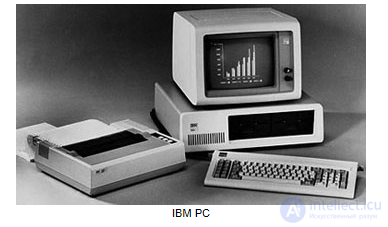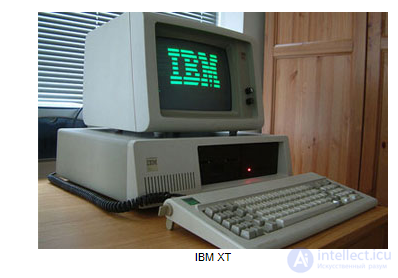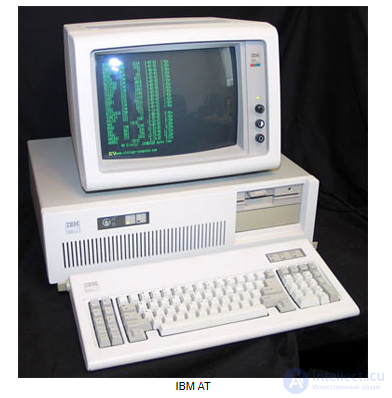Lecture
Time small personal computers
Until the 1980s, IBM was very active in large orders. Several times they were made by the government, several times by the military. As a rule, it supplied its mainframes to educational and scientific institutions, as well as large corporations. It is unlikely that someone bought a separate System / 360 or 370 cabinet for themselves or about a dozen storage cabinets on the basis of magnetic tapes and already reduced by a couple of times in comparison with RAMAC 305 hard drives.
The blue giant was above the needs of the average consumer, who needed much less to achieve complete happiness than NASA or another university. This gave a chance to stand on the feet of the half-basement Apple company with the logo in the shape of Newton holding an apple, soon replaced by just a bitten apple. And Apple came up with a very simple thing - a computer for everyone. This idea was not supported either by Hewlett-Packard, where it was presented by Steve Wozniak, or by other major IT companies of the time.
When IBM realized it was too late. The world has already admired the Apple II - the most popular and successful Apple computer in its history (and not the Macintosh, as many believe). But it's better late than never. It was not difficult to guess that this market is at the very beginning of its development. The result is an IBM PC (model 5150). It happened on August 12, 1981.
The most striking thing is that this was not the first IBM personal computer. The title of the first belongs to the model 5100, released in 1975. It was much more compact than mainframes, it had a separate monitor, data storage and a keyboard. But it was intended for solving scientific problems. For businessmen and just lovers of technology, he approached poorly. And not least because of the price, which was about $ 20,000.
Ibm PC
IBM PC has changed not only the world, but also the company's approach to the creation of computers. Prior to that, IBM was doing any computer from and to independently, without the help of third-party companies. IBM 5150 turned out differently. At that time, the personal computer market was divided between Commodore PET, the Atari 8-bit family of systems, the Apple II and TRS-80s from Tandy Corporation. Therefore, IBM was in a hurry not to miss the moment.
A group of 12 people working in the Florida city of Boca Raton under the leadership of Don Estrige (Don Estrige) was assigned to work on Project Chess (literally "Project Chess"). They coped with the task in about a year. One of their key decisions was the use of third-party development. This simultaneously saved a lot of money and time on our own scientific personnel.
Don originally chose the IBM 801 as the processor and the specially developed operating system for it. But a little earlier, the blue giant released the Datamaster microcomputer (full name System / 23 Datamaster or IBM 5322), based on the Intel 8085 processor (slightly simplified version of the Intel 8088). This is exactly what caused the choice for the first PCIBM Intel 8088 processor. In the IBM PC, even the expansion slots coincided with those of Datamaster. But Intel 8088 demanded a new DOS operating system, very timely proposed by a small company from Redmond called Microsoft. We did not make a new design for the monitor and printer. As the first, a monitor previously created by the Japanese division of IBM was chosen, and the Epson printer became the printer.
Ibm pc

IBM PC was sold in various configurations. The most expensive cost $ 3005. It was equipped with an Intel 8088 processor operating at a frequency of 4.77 MHz, which, if desired, could be supplemented with an Intel 8087 coprocessor that made floating-point calculations possible. The amount of RAM was 64 KB. As a device for permanent data storage was supposed to use 5.25-inch floppy drives. They could be installed one or two pieces. Later, IBM began to supply models that enabled the connection of cassette data carriers.
The hard disk in the IBM 5150 could not be installed due to insufficient power supply. However, the company is the so-called "expansion module" or Expansion Unit (also known as IBM 5161 Expansion Chassis) with a 10 MB hard drive. He demanded a separate power source. In addition, it was possible to install a second HDD. He also had 5 expansion slots, while the computer itself had another 8. But to connect the Expansion Unit, it was necessary to use the Extender Card and the Receiver Card, which were installed in the module and in the case, respectively. Other computer expansion slots were usually occupied by a video card, cards with I / O ports, etc. It was possible to increase the amount of RAM to 256 KB.
The cheapest configuration cost $ 1,565. Together with it, the buyer received the same processor, but the RAM was only 16 KB. A floppy disk drive was also not included with the computer, and there was no standard CGA monitor either. But there was an adapter for tape drives and a video card, focused on connecting to a TV. Thus, the expensive modification of the IBM PC was created for business (where, by the way, it became quite widespread), and cheaper for the home.
But there was one more novelty in the IBM PC - the Basic Input / Output System or the BIOS. It is still used in modern computers, albeit in a slightly modified form. The newest motherboards already contain new EFI firmware or even simplified versions of Linux, but it will definitely take several years before the BIOS disappears.
The IBM PC architecture has been made open and publicly available. Any manufacturer could make peripherals and software for an IBM computer without buying any license. At the same time, the blue giant was selling the IBM PC Technical Reference Manual, where the full BIOS source code was posted. As a result, a year later, the world saw the first "IBM PC compatible" computers from Columbia Data Products. Compaq and other companies followed. The ice has broken.
IBM Personal Computer XT
In 1983, when the whole of the USSR celebrated International Women's Day, IBM released its next "male" product - IBM Personal Computer XT (abbreviated from Xtended Technology) or IBM 5160. The novelty replaced the original IBM PC, presented two years earlier. It was an evolutionary development of personal computers. The processor was used all the same, but in the basic configuration there was already 128 Kbytes of RAM, and later 256 Kbytes. The maximum volume increased to 640 Kbytes.

Ibm xt
The XT came with a single 5.25 inch drive, a Seagate ST-412 10 MB hard drive and a 130 watt power supply. Later, there were models with a 20 MB hard drive. Well, as the base OS used PC-DOS 2.0. To extend the functionality, a 16-bit IISA bus was used at that time.
Ibm Personal Computer / AT
The AT standard is probably remembered by many old-timers in the computer world. They were used until the end of the last century. And it all started again with IBM and its IBM Personal Computer / AT or Model 5170 computer. AT stands for Advanced Technology. The new system was the second generation of personal computers of the blue giant.
IBM AT

The most important innovation was to use the Intel80286 processor with a frequency of 6 and then 8 MHz. Many new computer features were associated with it. In particular, it was a complete transition to a 16-bit bus and support for 24-bit addressing, which made it possible to bring the amount of RAM to 16 MB. A battery appeared on the motherboard to power the chip with a CMOS capacity of 50 bytes. Prior to that, it was not there either.
Data storage now used 5.25-inch drives with support for 1.2 MB of floppy disks, while the previous generation provided no more than 360 KB. The hard drive now had a constant capacity of 20 MB, and at the same time was twice as fast as the previous model. The monochrome video card and monitors were replaced with adapters that support the EGA standard, capable of displaying up to 16 colors in 640x350 resolution. Optionally, for professional work with graphics, it was possible to order a PGC video card (Professional Graphics Controller) worth $ 4290, capable of displaying up to 256 colors on a screen with a resolution of 640x480, and at the same time supporting 2D and 3D acceleration for CAD applications.
To support all this variety of innovations, we had to seriously modify the operating system, which was released under the name PC-DOS 3.0.
Still not a ThinkPad , no longer an IBM PC
We believe many know that the first portable computer in 1981 was Osborne 1, developed by Osborne Computer Corporation. It was such a suitcase weighing 10.7 kg and worth $ 1,795. The idea of such a device was not unique - its first prototype was developed back in 1976 at the Xerox PARC research center. However, by the mid-80s, the sales of the “Osbourns” had disappeared.
Of course, a good idea was quickly picked up by other companies, which, in principle, is in the order of things - it’s enough to recall what other ideas were stolen from Xerox PARC. In November 1982, Compaq announced plans to release a laptop computer. In January, Hyperion was released - a computer running under MS-DOS and somewhat reminiscent of Osborne 1. But it was not fully compatible with the IBM PC. This title was prepared for Compaq Portable, which appeared a couple of months later. In fact, it was an IBM PC combined in a single package with a small screen and an external keyboard. The “suitcase” weighed 12.5 kg and was estimated at over $ 4000.
IBM, clearly noticing that it was missing something, quickly took up the creation of its primeval laptop. As a result, in February 1984, the world saw the IBM Portable Personal Computer or the IBM Portable PC 5155. The new product also resembled the original IBM PC in many ways, with the exception that the RAM in it was installed 256 KB. In addition, he was $ 700 cheaper than the analog from Compaq, and at the same time he had improved anti-theft technology - weighing 13.5 kg.
Two years later, progress has advanced a couple of steps forward. This did not hesitate to use IBM, deciding to make their laptops with something more justifying their rank. So in April 1986, the IBM Convertible or IBM 5140 appeared. The convertible was no longer a suitcase, but a large case weighing only 5.8 kg. It cost about half the price - about $ 2,000.
As a processor, the good old Intel 8088 (or rather its updated version 80c88), operating at 4.77 MHz, was used. But instead of 5.25-inch drives used 3.5-inch, capable of working with disks with a capacity of 720 KB. The amount of RAM was 256 KB, but it could be increased to 512 KB. But a much more important innovation was the use of a monochrome LCD display capable of 80x25 resolution for text or 640x200 for 320x200 for graphics.
But the expansion capabilities of Convertible were much more modest than those of the IBM Portable. There was only one ISA slot, while the first generation of the blue giant's portable PCs made it possible to install almost as many expansion cards as a regular desktop computer (even if it didn’t allow for such dimensions). This circumstance, as well as a passive screen without backlighting and the availability of more productive (or models with the same configuration, but available at a much lower price) analogues from Compaq, Toshiba and Zenith, did not make IBMContible a popular solution. But it was manufactured until 1991, when the IBM PS / 2 L40 SX was replaced. About PS / 2 tell more.
Comments
To leave a comment
History of computer technology and IT technology
Terms: History of computer technology and IT technology